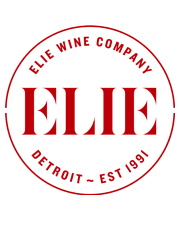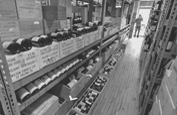An Invitation to Join ‘The Champagne Society’
JOIN THE CHAMPAGNE SOCIETY
Subscribe to our bimonthly Champagne Club. Please, call us at 248-398-0030 or email elie@eliewine.com
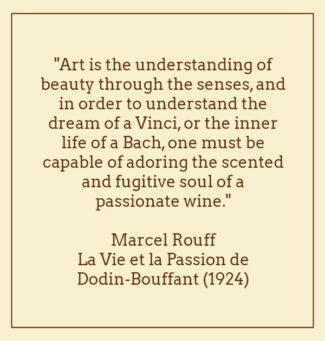 As a member of The Champagne Society, you’re in a select community of like-minded folks who appreciate the exceptional in life and recognize that sparkling wine is a superlative among man’s culinary creations. A bottle of Champagne is selected for you bimonthly. You will be drinking some of the best Champagne ever produced.
As a member of The Champagne Society, you’re in a select community of like-minded folks who appreciate the exceptional in life and recognize that sparkling wine is a superlative among man’s culinary creations. A bottle of Champagne is selected for you bimonthly. You will be drinking some of the best Champagne ever produced.
All selected wines are from passionate grower-producers or small houses deeply connected to the subtleties of each of their vine parcels and who believe that wine is made in the vineyard. Many of these wines are highly allocated, many bought directly, and we quite often only have access to a few cases of a particular cuvée.
As a member of The Champagne Society expect the following benefits:
• The selected Champagne quite often is not available in any other wine shop in Michigan and only in a few places, if any, in the country. We compete with savvy wine buyers in the European and the Far East markets to secure some of the allocations from these sought-after makers.
• The selection is released every other month and ready for pickup by the 10th of that month, or shipped if you prefer. Expect a new bottle in February, April, June, August, October and December.
• The price is always less than $100 and reflects 15% discount of the store price when we have additional quantities to sell to non-members. Champagne available, members may purchase any number of additional bottles at the same discounted price.
• We notify you via email when the installment selection is released in a newsletter that profiles the producer and the cuvée chosen. The newsletter is also posted on www.eliewine.com . Only then your credit card is charged and you are sent a separate purchase receipt.
• You can pause or cancel your membership at any time.
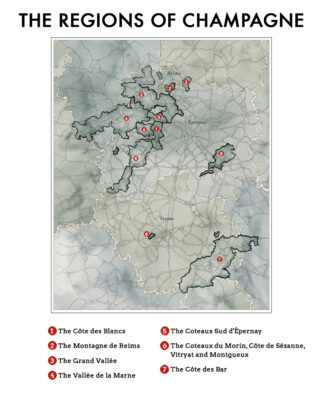
THE CHAMPAGNE SOCIETY DECEMBER 2021 SELECTION
Champagne Fleury
Ecological Pioneer with Purpose and Passion
(Côte des Bar)
Cépages Blancs Extra-Brut 2010 OR Sonate 2012 Extra-Brut ‘Natural’ *
*Special Price for members of the Champagne Society is $88. Not available to non-members (Sold out). Six other cuvées are available. See end of newsletter.
The Côte des Bar is located in the southern part of the Champagne production area, where climate, geography and careful vine husbandry combine to produce delicate, aromatic wine that is highly prized among the master blenders of Champagne’s most heralded labels. The land itself is a patchwork of vineyards planted on Jurassic slopes that overlie limestone bedrock with multiple exposures; the lush valleys that predominate throughout the Côte des Bar connect with those of the Seine and the Aube. The region encompasses 62 villages (divided between sub-regions Bar sur Abois and Barséquanais) and contains about 20,000 acres planted primarily to Pinot Noir, with about 12% Chardonnay and another four percent of Meunier.
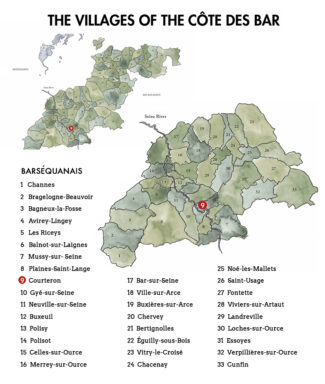
In the Côtes de Bar, Fleury plays two roles; it is a star long established in the Champagne heavens and a new star rising. In 1929, at the outset of the Great Depression, wholesale grape prices fell so sharply that grower Robert Fleury decided to start bottling his own Champagne. The estate itself had been founded nearly three decades earlier in Courteron, in the Aube district, where two rivers once converged to form the Seine. These ancient waters created slopes on which the Fleury family now owns ten plots, a total of forty acres planted primarily to Pinot Noir. The oldest vines were planted in 1970, and new cuttings are established every year to maintain the vitality that younger vines bring to Champagne.
Biodynamics are key to the current ideology at Fleury, pioneered by Jean-Pierre Fleury, whose interest in sustainable farming began in the 1970s when he tried using manual tilling (as opposed to herbicides) and composting (as opposed to synthetic fertilizers). He began a trial with biodynamics on a few acres, and in 1992 used it across the whole of his vineyard holdings. Today, his son Jean-Sébastien Fleury carries on the mission, understanding that at its most basic definition, ‘terroir’ means soil. “The key is soil health,” he maintains. ‘We must keep the earth healthy. The structure of the soil gives back the essence of the terroir’

Appreciate the Balance and Share the Mysteries of Nature
The Japanese have long espoused a mystical connection between the earth and sky; a spectacle of nature and the subtle balance that prevails between tradition and modernity. That is a philosophy that winemaker Jean-Sébastien Fleury, only twenty-three years old, grew up with. His father, Jean-Pierre, who originally wanted to be an astronomer, embraced the concept that every human on earth has a small but essential role in maintaining the harmony of the universe, and fell in love with cultures founded on principles of equity, between people and with the land, and decided early to raise his family in physical and spiritual health.
Champagne is especially suited to this thought process; at its core, it is an attempt to find a nearly magical equilibrium between nature and man’s ability to enhance it. An understanding of the microcosm and the macrocosm is essential to a biodynamic vision, and as an homage to the interdependence of earth and sky, Fleury vineyard practices seemed—in the last century—as almost druidic, although they are now being embraced throughout France.
Enhancing and Understanding Terroir’s Character
Champagne is uniquely situated to take advantage of a multitude of superlatives in land and sky; the relatively northerly latitude and nearness to the ocean subject it to dual climates, oceanic and continental. The soil is a mosaic, structured with a subterranean limestone layer that acts to retain moisture and allows grapes to thrive in dry seasons and survive droughts. Combined with good hillside drainage, Jean-Sébastien Fleury wisely touts this topographical advantage: “The subsoil here is even more important to the vines than the soil.”
He goes on to explain that the silica in the earth produces lightness and aromatic finesse in a wine, whereas the marly and clay limestone beneath the surface adds alcoholic strength. “The closer the rock is to the surface,” he says, “the finer the Champagne.”
The estate is near the Plateau of Langres, and Fleury says that this is equally important to the signature terroir. But, as always, it is the touch of man that produces Champagne in concert with climate and soil. “Incorporating all these factors strengthens our knowledge of nature’s rhythms and improves the care we give to the plants and fruits so that the terroir reveals its character.”
The Biodynamic Principles: Respecting Earth’s Life Forces
The Fleury family looks at the estate as a living organism and pampers it as one might a beloved family pet. “We have been cultivating our land in line with its habitat for more than thirty years, acknowledging nature’s rhythms and the influence of terrestrial and cosmic forces. At first, this agricultural principle may seem demanding and esoteric, but it is truly a virtuous circle. We envision wine as a support of nature’s creation and undeniably enhances the product we bottle.” All wines are labeled ‘Organic Agriculture TM’ and ‘Biodynamic.’
Fleury delves deeper: “A vineyard is a monoculture, so our work is directed toward increasing biodiversity. Our viticultural work is focused on both the soil and the plant. Cultivation is done by hand in addition to the application of biodynamic preparations. Vine work is synchronized with planetary and lunar cycles; this is based on the effects these heavenly bodies have on root, leaf, flower and fruit development. For example, vine suckering, de-leafing and de-budding is done on ‘leaf day’ in the lunar calendar. The grafts and harvest is done in accordance with the lunar spring, when the moon is rising, a time that favors heavy sap flow. The lunar fall, when the moon is descending, is the best time for pruning.”
Vinification and the Winery: Producing Earth’s Best
In keeping with this overall view, Jean-Sébastien considers Fleury wine to be an expression of harmony; the earth’s quintessence. And yes, according to the estate’s vinification guidelines, the bottling is done on earth’s ‘fruit day.’ Before that, the grapes, hand-picked, are crushed and pressed in two 4000 kg. wooden hand-presses, and a third which is automated. Champagne production is, by its nature, labor intensive, but to make it even more exacting (and labor be damned) the Fleury family vinifies each of their ten lots separately, allowing them to better track the quality of the fruit from individual parcels. “Like a painter with a palette of colors, we assemble cuvées from grapes with different characteristics based on terroir and history.”
After fermentation, the wine remains on its lees until spring, and is first tasted at the spring equinox, and again in late April; these are critical steps wherein the wine is carefully evaluated before assembling the blend. In a system known as ‘inverse solera’, they then blend raw wine from the previous vintage with reserved wine from previous years, saving a portion of the new wine to top off the stock. This is a variation on the classic method for assembling Sherry: ‘La Solera inversée’ is a unique approach, and Jean-Sébastien is credited with creating a ‘time library’ of foudres containing earlier vintages housed in a timber-framed gallery.
The cuvées are aged with circumspection; three to five years for the Blanc de Noirs, Rosé and Fleur d’Europe and up to ten years for the Millésimes. As in all things ‘Fleury’, even the downtime of aging carries with it metaphysical symbolism, and it is referred to as ‘returning the product to its original land’ before exposing it to light again during the tasting. In the end, all elements harmonize, revealing the purity of process and the subtlety of nature.
Due to limited releases members will be assigned one of the following cuvées:
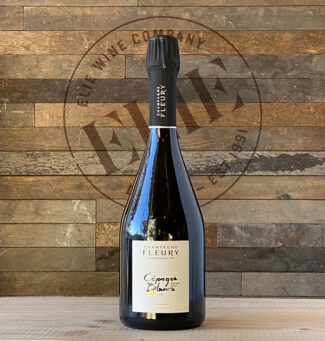 ‘Rainbow White’
‘Rainbow White’
Cépages Blancs Extra-Brut 2010 ($88)
An exclusive Blanc de Blanc made from the estate’s best plots of Chardonnay (Champraux and Valprune), where old vines have penetrated deeply into the Kimmeridgian subsoils. 2010 was a fairly difficult year in Champagne, with dry conditions retarding grape development early in the season. When rain arrived in August it was torrential, causing widespread disease pressure, but Chardonnay fared very well where Pinot Noir did not. The return of dry conditions in September was a godsend, but meticulous vignerons like the Fleury family understood that sorting in the vineyard and winery was crucial. The wine itself is majestic, with notes of white flowers, acacia honey, brioche, toasted bread rolls and dried stone fruits.
OR
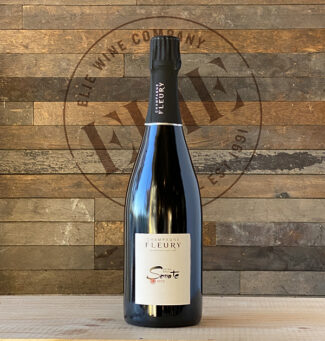 ‘The Music of Time and Space’
‘The Music of Time and Space’
Sonate 2012 Extra-Brut ‘Natural’ ($88)
A somewhat traditional Champagne blend—78% Pinot Noir and 22% Chardonnay—the cuvée is a splendid showcase for the exceptional 2012 vintage, where frost and hail reduced yields early in the season, and a warm summer produced exemplary acidity and grape health in the fruit that remained. ‘Sonate’ resonates with a blend of 35-year-old vines from the Champraux and Charme de Fin plots; it opens gradually and quickly improves, showing perfect balance between acidity, softness and tannins. Brown spices appear quickly, with nutmeg suggesting mature tones while acids provide a ghost of freshness. Beyond this, the palate is rich with bright cherry, apple crisp and honeyed croissant.
Champagne Fleury’s other cuvées …..
 ‘When Mars Meets Venus’
‘When Mars Meets Venus’
‘Rosé de Saignée’ 2015 Brut ($68)
Winemaker Notes:
100% Pinot Noir from 30-year vines. Color is obtained by short maceration of the grapes before pressing. Malolactic fermentation. No dosage.
This wine has a bright ruby tinted color. With a delightful bouquet of fresh red fruits, blackcurrants and plum pie, the aromas combine both richness of vinosity. Aging potential is between 3 and 5 years.
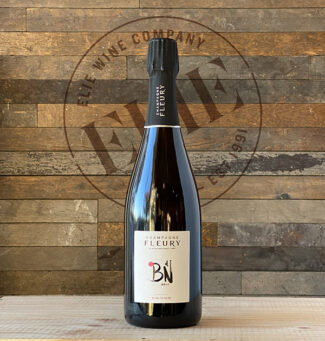 ‘Pinot Noir Planet’
‘Pinot Noir Planet’
‘Blanc de Noirs’ Brut ($55)
Winemaker Notes:
100% Pinot Noir. Originally created in 1955 by Robert Fleury, we changed the name of our classic cuvée to “Blanc de Noirs Brut” in 2010. Every new vintage is added to the previous vintage to create a perpetual reserve in large casks, a process also known as the “Solera” method. The cuvée is then aged “sur lattes” for four years. Blending 2016 (30%) and reserve wines (70%) with fermentation completed in thermo-regulated tanks and wooden tuns for reserve wines. Malolactic fermentation. Dosage is 3.6 grams/liter.
This pure Pinot Noir with straw-gold tints reveals an elegant and expressive nose, with delicate aromas of white peach and iris. Fresh on the palate with a crisp structure and lasting fruity flavors. Aging potential is between 3 and 5 years.
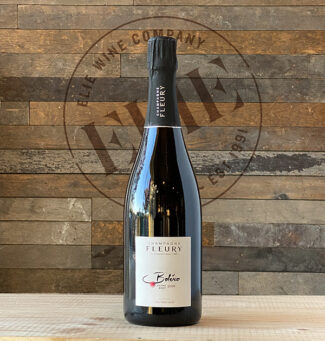 ‘The Notes of Twilight’
‘The Notes of Twilight’
‘Boléro’ 2009 Extra-Brut ($115)
Winemaker Notes:
100% Pinot Noir from 25-year old vines in Charme de Fin, Côte de Champraux, Meam Bauché and Montégné parcels. Last in production in 1990, this cuvée made a reprise in 2004. Fermentation is completed in thermoregulated tanks (50%) and oak barrels (50%). Malolactic fermentation is in the bottle under cork with ‘agrafe’. Residual sugar is 3.2 grams/liter naturally with no dosage.
The vintage expresses an array of complex aromas, dried fruits, toasted almonds, apricots, followed by herbaceous and mineral notes. On the palate we find flavors of freshly baked-bread, and juicy grapes, with a crystalline effervescence. Aging potential is between 5 and 10 years.
 ‘The Sun has a Meeting with the Moon’
‘The Sun has a Meeting with the Moon’
‘Fleur de l’Europe’ Brut Nature ($60)
Winemaker Notes:
85% Pinot Noir and 15% Chardonnay. The first ever biodynamic cuvée in Champagne! The Europe which witnessed the fall of the Berlin Wall inspired the name of this wine. The ethereal and floral Chardonnay brings a special elegance to this cuvée. Despite at first receiving a dosage, it has been zero-dosage for the last 10 years. Blending 2014 (75%) and reserve wines (25%) with fermentation completed in thermoregulated tanks and oak barrels. Reserve wines are aged in oak tuns. Malolactic fermentation. No sugar added.
A Brut Nature Champagne, expressive with exceptional finesse! A bright gold robe carries aromas of honey and acacia. The mouthfeel is ample and generous with a surprising freshness. This is a chiseled wine, mouth- wateringly vibrant, with a touch of salinity. Aging potential is between 3 and 5 years.
 ‘Memories of a Star’
‘Memories of a Star’
‘Notes Blanches’ 2014 ($93)
Winemaker Notes:
100% Pinot Blanc from 25-year old vines in Charme de Fin and Valverot parcels. Although a variety in Champagne, Pinot Blanc has typically only been found in blends. However, in 2009 this rare, expressive and exotic variety was granted its own pure mono-varietal cuvée. Free of any dosage, this is definitely one to discover! No dosage.
On the palate there is an ample bouquet with aromas of yellow fruits and white pepper, enveloped by a supple texture and an energetic finish. Aging potential is between 3 and 5 years.
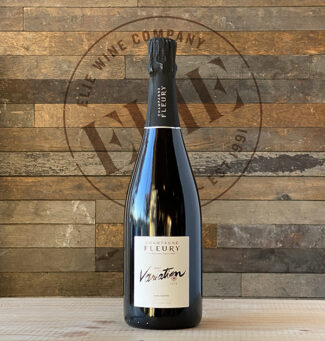 ‘Return of the Eclipse’
‘Return of the Eclipse’
‘Variation’ 2014 Brut ‘Natural’ ($130)
Winemaker Notes:
100% Pinot Gris. As a result of its vinification in oak, this wine has a powerful and complex nose, with a unique blend of aromas, yellow fruits, tropical fruits, and almonds. Fresh and crisp on the palate this wine is full of aromatic delights, which are enveloped by an ample mouthfeel and a long and expansive finish. Malolactic fermentation. No dosage. Aging potential is between 3 to 5 years.
- - -
Posted on 2021.12.01 in Santenay, Côte de Beaune, France, Burgundy, The Champagne Society, Champagne, Wine-Aid Packages | Read more...
The Gesture of Being Natural, All About the Fruit: From Vineyard to Table by 9 Grower-Producers (8-Bottle Pack $230) + Champagne & Pét-Nat in the Raw
In wine, ‘natural’ is a concept before it’s a style. It refers to a philosophy; an attitude. It may involve a regimen of rituals or it may be as simple as a gesture, but the goal, in nearly every case, is the purest expression of fruit that a winemaker, working within a given vineyard, can fashion. Not all ‘natural’ wines are created equal, and some are clearly better than others, but of course, neither is every estate the same, nor every soil type, nor each individual vigneron’s ideology.
The theory is sound: To reveal the most honest nuances in a grape’s nature, especially when reared in a specific environment, the less intervention used, the better. If flaws arise in the final product—off-flavors, rogue, or ‘stuck’ fermentation (when nature takes its course), it may often be laid at the door of inexperience. Natural wine purists often claim that this technique is ancient and that making wine without preservatives is the historical precedent. That’s not entirely true, of course; using sulfites to kill bacteria or errant yeast strains dates to the 8th century BCE. What is fact, however, is that some ‘natural’ wines are wonderful and others are not, and that the most successful arise from an overall organoleptic perspective may be those better called ‘low-intervention’ wine, or ‘raw’ wine—terminology now adopted by many vignerons and sommeliers.
At its most dogmatic and (arguably) most OCD, natural wines come from vineyards not sprayed with pesticides or herbicides, where the grapes are picked by hand and fermented with native yeast; they are fined via gravity and use no additives to preserve or shore up flavor, including sugar and sulfites. Winemakers who prefer to eliminate the very real risk of contaminating an entire harvest may use small amounts of sulfites to preserve and stabilize (10 to 35 parts per million) and in natural wine circles, this is generally considered an acceptable amount, especially if the estate maintains a biodynamic approach to vineyard management.
In all things wine, ‘balance’ is a key to the kingdom; it is a term interchangeable with harmony, and may reference acid, alcohol level, grape sugars and tannin, but also, to a scale in which the long-term health of the product is considered along with the flavors inherent on release. More than just a current radar blip in trendy social capital a naturalistic approach to winemaking is not only more honest, but better for a sustainable environment: It’s a nod to the past and a gesture to the future.
This special package contains one of each of the following 8 wines for $230.
SPAIN
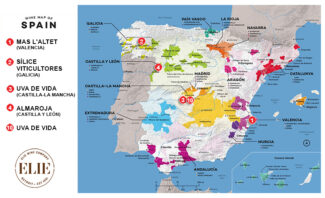
Bodega Mas L’Altet
What do you get if you mix an bio-engineer from Belguim with another engineer from Alicante? If they both happened to be oenologists, you get Nina Coolsaet and Alfredo Esteve and a marriage born among vine canopies. The couple met at a Master of Oenology course in Aranda del Duero, and soon thereafter went to work on Bodega Mas L’Altet, an ancestral property in Agres (in southern Valencia) that Alfredo’s beloved grandfather had hoped to develop into a winemaking estate. The young couple restored the farmhouse where Alfredo’s mother was born and began to tend their scant five acres of vines as if it was ‘our garden’. At an elevation of nearly two thousand feet, the soils have a remarkable ability to retain water, making Mas L’Altet a rare vineyard that does not rely on irrigation to produce delicate wines with a robust backbone.
 Mas L’Altet ‘Avi’, Valencia 2013, ($31): Named for Alfredo’s grandfather (‘Avi’ means grandfather in Catalan language), the wine is 70% Syrah, 21% Cabernet Sauvignon and 9% Garnacha, a wonderful blend that draws structure from the Cab, fruit from the Syrah, and richness and spice from the Garnacha. Only 538 cases made.
Mas L’Altet ‘Avi’, Valencia 2013, ($31): Named for Alfredo’s grandfather (‘Avi’ means grandfather in Catalan language), the wine is 70% Syrah, 21% Cabernet Sauvignon and 9% Garnacha, a wonderful blend that draws structure from the Cab, fruit from the Syrah, and richness and spice from the Garnacha. Only 538 cases made.
Sílice Viticultores
Sílice Viticultores is a joint venture between brothers Juan and Carlos Rodriguez with Priorat and Montsant producer Fredi Torres; beyond their Galician roots, the glue that binds the relationship is an abiding love for Ribeira Sacra. Working with six small vineyards where the vines rage in age from forty years to over a hundred, they elicit elegancy and finesse from a roster of indigenous varietals spread across the steep slate and granite slopes of Amandi. They farm biodynamically and refer to their cellar as ‘a place of minimal intervention.’
 Sílice Viticultores ‘Sílice’, Galicia 2016, ($26): 80% Mencía, 5% Albarello, 5% Merenzao, 5% Godello, 5% Garnacha Tintorera, the wine shows violet on the nose with a ripe, red fruit body punctuated by spice and earth. 1036 cases made.
Sílice Viticultores ‘Sílice’, Galicia 2016, ($26): 80% Mencía, 5% Albarello, 5% Merenzao, 5% Godello, 5% Garnacha Tintorera, the wine shows violet on the nose with a ripe, red fruit body punctuated by spice and earth. 1036 cases made.
Uva de Vida
“If we take care of the earth, we take care of ourselves,” says Uva de Vida owner Maria Carmen López Delgado. “Life has given me a new opportunity.” After recovering from serious illness, Delgado felt a spiritual connection to the natural world that convinced her to plant vineyards in the dry terrain of Castilla. With her husband Luis Ruiz, she planted 25 acres of Graciano and eight of Tempranillo and set out to establish a farming philosophy that not only eschews artificial soil additives, but arranges vines in a complex geometric diagram to take advantage of the specific vibrations of energy found at 40˚ latitude. In addition, as the wine ferments and ages, music is piped into the cellar, because Delgado also believes in the power of sound vibrations to improve the health of her product.
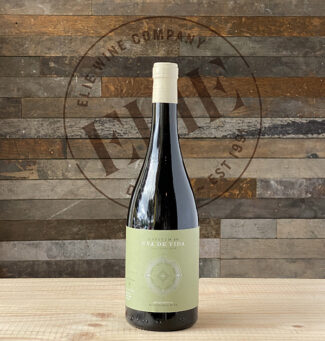 Uva de Vida ‘Latitud 40’, Vino de la Tierra de Castilla 2018, ($23): is 100% Graciano and is perfumed with aromas of mulberry, violets and chocolate complemented by vanilla and spice. 416 cases made.
Uva de Vida ‘Latitud 40’, Vino de la Tierra de Castilla 2018, ($23): is 100% Graciano and is perfumed with aromas of mulberry, violets and chocolate complemented by vanilla and spice. 416 cases made.
Almaroja
‘Almaroja’ means ‘red soul’ and winemaker Charlotte Allen, a British ex-pat living in Spain, says, “Red symbolizes vitality, courage, optimism, nonconformity and passion.” All of these attributes are integral to the soul of this iconoclastic woman and her deep love for the rugged terroirs of Zamora. She operates (for the most part) alone, adhering to the best of biodynamic practices, working on weaker parcels on specific dates and times, treating her vineyard for pest with botanical blends, including sage and nettle. She hand-harvests a scant half-ton per acre and grows a number of spectacular grapes little known outside her region.
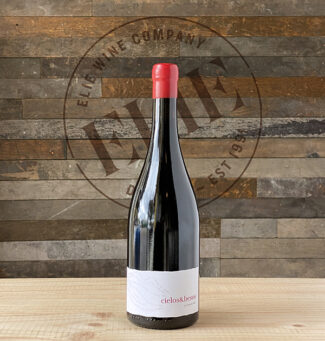 Almaroja ‘Cielos y Besos’, Arribes 2019, ($21): Made of blend that relies heavily on Juan García, an indigenous grape in the Arribes (known for its brilliant purple hue on the vine), and Tempranillo from Charlotte’s ‘young’ vines which are fifty years old. Deep burgundy red with a violet rim, the wine elicits aromas of rustic wild berries, pepper, and finishes with ripe tannins and stony minerals. 300 cases made.
Almaroja ‘Cielos y Besos’, Arribes 2019, ($21): Made of blend that relies heavily on Juan García, an indigenous grape in the Arribes (known for its brilliant purple hue on the vine), and Tempranillo from Charlotte’s ‘young’ vines which are fifty years old. Deep burgundy red with a violet rim, the wine elicits aromas of rustic wild berries, pepper, and finishes with ripe tannins and stony minerals. 300 cases made.
FRANCE

Famille Dutraive
Only about 4% of Beaujolais is farmed organically, and even less in Saint-Amour, the romantically-named, most northerly of the ten Crus. Still, the Dutraive family—consisting of Jean-Louis Dutraive and his children Ophélie, Justin and Lucas, are committed to sourcing fruit grown with a commitment to the planet. In the cellar, they continue practices that they view as integral to sustaining the purity of the terroir, vinifying on natural yeasts without additives beyond a tiny amount of sulphur at bottling. The elder Dutraive, who abandoned conventional farming in favor of organic many years ago, says, “I have become one with my vines and wines. Even with near perfect work in the vineyard of a great terroir, one must observe more and react less.”
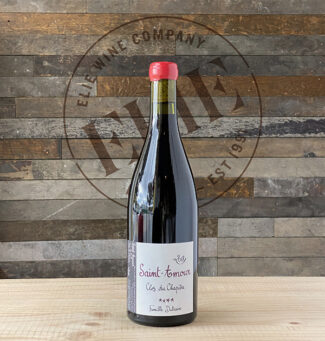 Famille Dutraive, Saint-Amour ‘Clos du Chapitre’, 2018 ($46): Grown in ancient alluvial soils from vines planted in the eastern part of Saint-Amour appellation in the 1970s, the Dutraives’ signature cuvée shows lovely bouquet of ripe cherries, raspberries, licorice and wood smoke. This is a stony terroir with clay below the surface, so the family presses comparatively early and lets the wine finish its ferment in concrete, steel and neutral oak.
Famille Dutraive, Saint-Amour ‘Clos du Chapitre’, 2018 ($46): Grown in ancient alluvial soils from vines planted in the eastern part of Saint-Amour appellation in the 1970s, the Dutraives’ signature cuvée shows lovely bouquet of ripe cherries, raspberries, licorice and wood smoke. This is a stony terroir with clay below the surface, so the family presses comparatively early and lets the wine finish its ferment in concrete, steel and neutral oak.
Château du Cèdre
Cahors is about two hours’ drive from Bordeaux, but the wines, stylistically, are a universe apart. Made predominantly from Malbec, the wines are called ‘black’ for their brooding intensity. Pascal Verhaeghe and his brother, Jean-Marc have succeeded in adding refinement to the wines their father made at Château du Cèdre in the 1970s, banning all herbicides and chemicals, and adopting a motto ‘Move forward, experience new ways.’ Building upon the estate’s rich terroir, they are now producing polished wines that are quite approachable when young, but also age exceptionally well.
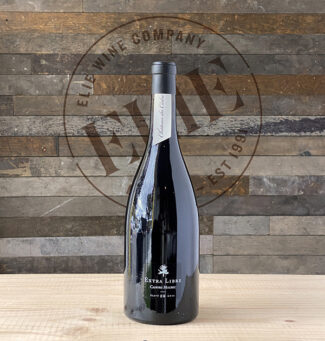 Château du Cèdre ‘Extra Libre’, Cahors 2019, ($31): 90% Malbec, 5% Merlot and 5% Tannat, the wine, grown in limestone scree, receives no input from the winemakers for thirty days; it is bottled without sulfites and rich tannins and brisk acidity act as the sole preservatives. From vines between fifteen and thirty years old, it offers accessible, velvety flavors of cassis, blackberry, truffles, dark chocolate and spice behind a firm backbone of earth, oak and minerals.
Château du Cèdre ‘Extra Libre’, Cahors 2019, ($31): 90% Malbec, 5% Merlot and 5% Tannat, the wine, grown in limestone scree, receives no input from the winemakers for thirty days; it is bottled without sulfites and rich tannins and brisk acidity act as the sole preservatives. From vines between fifteen and thirty years old, it offers accessible, velvety flavors of cassis, blackberry, truffles, dark chocolate and spice behind a firm backbone of earth, oak and minerals.
Domaine Philippe Badéa
The husband and wife team of Agnes and Philippe Badéa paid their dues at Domaine Jean David in Séguret, spending twenty years producing classic and traditionally made organic wines. In 2010 they purchased ten acres of old-vine Grenache in the village of Tulette in the heart of the Côtes du Rhône. Of these, six acres were planted in 1945 and four acres in 1982. The soils are rich in clay-limestone with some silex, and they are so committed to organic farming (following the lunar calendar and treating pests with herbal preparations like ‘ortie piquante’, stinging nettle) that well-meaning family referred to them as ‘zinzin’, local slang for ‘bonkers.’ Having taken to this gentle nickname, they named their wine ‘Foulée des Zinzins’—‘The Stride of the Crackpots.’
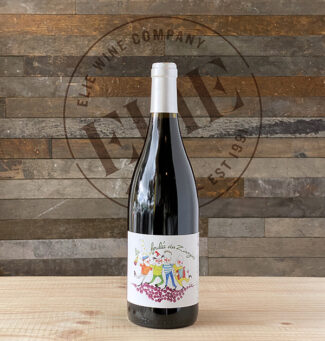 Philippe Badéa ‘La Foulée des Zinzins – Grenache’, Vin de France – Southern Rhône 2020 ($18): 100% Grenache, the wine is produced via spontaneous fermentation with native yeasts and neither fined nor filtered. The wine percolates with floral aromas and juicy red fruit punctuated with spicy notes of cinnamon. Less than 1000 cases made.
Philippe Badéa ‘La Foulée des Zinzins – Grenache’, Vin de France – Southern Rhône 2020 ($18): 100% Grenache, the wine is produced via spontaneous fermentation with native yeasts and neither fined nor filtered. The wine percolates with floral aromas and juicy red fruit punctuated with spicy notes of cinnamon. Less than 1000 cases made.
Complemen’Terre
The terroir is a magnificent mouthful (gneiss, orthogneiss, granite and amphibolite) and a result, so is the wine. Having learned their winemaking chops in Chile and New Zealand as well as closer to home in Montlouis, Manu Landron and Marion Pescheux purchased twenty acres in some of the best land in the Muscadet AOC. With help from Manu’s father—one of the legendary producers in the area—the couple set out to farm biodynamically, and became certified as such, adhering to a strict regimen that includes settling in underground concrete tanks before racking into smaller vats for fermentation and élevage. All of the wines undergo malolactic fermentation, and minimal, if any, sulfur is added.
 Complemen’Terre ‘Champ Geffray,’ Muscadet Sèvre et Maine 2019, WHITE ($34):2019 is an iconic example of the estate’s Muscadet, coming from an unusual vineyard with sandstone soils and 50 year-old vines on a steep southwest facing hill above the river Sevre. The wine shows intriguing aromas of dried pear and apricot, grapefruit peel, almond and stone with a bit of mint and spice with umami taste and preserved lemon flavors over a light and crystalline palate.
Complemen’Terre ‘Champ Geffray,’ Muscadet Sèvre et Maine 2019, WHITE ($34):2019 is an iconic example of the estate’s Muscadet, coming from an unusual vineyard with sandstone soils and 50 year-old vines on a steep southwest facing hill above the river Sevre. The wine shows intriguing aromas of dried pear and apricot, grapefruit peel, almond and stone with a bit of mint and spice with umami taste and preserved lemon flavors over a light and crystalline palate.
The following two wines are specially priced as an add-on to the previous package.
… Sparkling in the Raw
Champagne Fleury (Champagne, France)
Now many generations deep, the Fleury family farm about forty acres on the chalky-clay slopes of the Côte des Bar in the southern part of the Champagne region at the spot where the first tributaries flow into the Seine. Certified Organic by Ecocert in 1992, they dry-farm and harvest manually. “We were the first Champagne producers using biodynamics”, says Jean-Sébastien Fleury, “and now we are the largest. The conversion came through the hands of my father, Jean-Pierre, whose interest in sustainable wine growing began in the 1970s when he tried using manual tilling as opposed to herbicides, and composting as opposed to synthetic fertilizers. He began a trial with biodynamics, applying it to just 7 acres in 1989 and then across the whole of our vineyard holdings in 1992.”
 Champagne Fleury ‘Sonate’, Côte des Bar 2012 Extra-Brut ($84): From 35-year old vines in two parcels (Côtes de Champraux and Charme de Fin) in the village of Courteron with a biodynamic balance between the strength of Pinot Noir (78%) and the freshness of Chardonnay (22%), the bouquet contains aromas of citrus fruits, minerals, white peaches and a crisp acidity laced with minerals at the finish. No sulfites added.
Champagne Fleury ‘Sonate’, Côte des Bar 2012 Extra-Brut ($84): From 35-year old vines in two parcels (Côtes de Champraux and Charme de Fin) in the village of Courteron with a biodynamic balance between the strength of Pinot Noir (78%) and the freshness of Chardonnay (22%), the bouquet contains aromas of citrus fruits, minerals, white peaches and a crisp acidity laced with minerals at the finish. No sulfites added.
Uva de Vida (Pétillant Naturel, Spain)
Another gem from Maria Carmen López Delgado’s small, biodynamic farm in the Santa Olalla area of Toledo.
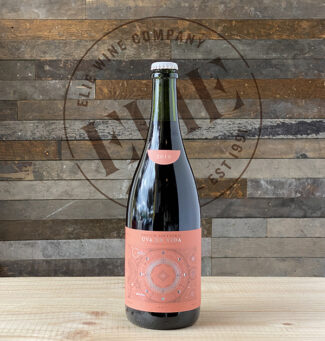 Uva de Vida ‘Rosado Ancestral,’ Vino de la Tierra de Castilla 2019 ($29): is produced from young Tempranillo vines—a portion of the fruit that is also used for the winery’s still ‘Biografico Tempranillo.’ The grapes are hand harvested from Delgado’s eight acres of Tempranillo and spend only a few hours on the skins; this is followed by natural fermentation, and the traditional ‘pét-nat’, short for ‘Pétillant Naturel’—a method so old that the French term for it is ‘méthode ancestrale.’ The wine shows intensely floral aromas; pure, deep, resonant and alive. Only 125 cases produced.
Uva de Vida ‘Rosado Ancestral,’ Vino de la Tierra de Castilla 2019 ($29): is produced from young Tempranillo vines—a portion of the fruit that is also used for the winery’s still ‘Biografico Tempranillo.’ The grapes are hand harvested from Delgado’s eight acres of Tempranillo and spend only a few hours on the skins; this is followed by natural fermentation, and the traditional ‘pét-nat’, short for ‘Pétillant Naturel’—a method so old that the French term for it is ‘méthode ancestrale.’ The wine shows intensely floral aromas; pure, deep, resonant and alive. Only 125 cases produced.
- - -
Posted on 2021.11.30 in Saint-Amour, Muscadet, France, Beaujolais, Spain DO, Champagne, Wine-Aid Packages, Loire, Southern Rhone, South West, Arribes, Tierra de Leon, Valencia, Ribeira Sacra | Read more...
Thanksgiving Wine Lineup: Seven Wines to Serve from Beginning to End + Dry Hard Cider from Brittany (France) Earns a Place at the Table (8-Bottle Package $220)
The spotlight of Thanksgiving is an expression of gratitude—for the bounty and for the providers. This extends to every phase of the celebration, family to feast, and in the rush of preparation, wines either get pushed to a back-burner or, on occasion, overthought.
Recognizing this, we’ve put together an affordable, all-things-considered beverage package to see you safely through the conundrum, with a special emphasis on matching the food and the mood.
SERVE BEFORE DINNER
Arriving guests may feel festive and frazzled, and your ‘bienvenue’ should be low-octane and refreshing, since it is meant to be an overture that sets the tone for the rest of the experience. These selections shatter the ice with crisp acidity and forward fruit and are able to act as a foil to any number of unctuous, strongly-flavored hors d’oeuvres.
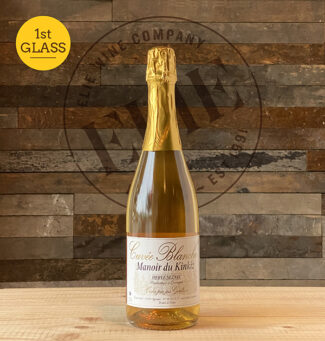 1 – Hard Cidre
1 – Hard Cidre
(Cornouaille), Manoir du Kinkiz ‘Cuvée Blanche’ ($17): Cider is an ideal opening salvo, and French have long treated fermented apple juice with the near- reverence of wine, passing laws that restrict apple varieties and delineate appellations. Blanche is made from a single variety called Guillevic and is known for its faint golden, almost white juice. Fruity, dry and often aged in oak foudres, the beverage is best served chilled. 4.5% alc.
 2 – WHITE
2 – WHITE
Penedès 2020, Can Sumoi ‘Perfum’ ($22): Higher altitude wines tend to preserve acidity and reflect floral aromatics; grown at nearly two thousand feet, Can Sumoi ‘Perfum’ is a blend of Muscatel, Macabeu, Malvasía and Parellada and offers remarkable bouquet of jasmine, peach blossom and roses. Serve chilled. 11% alc.
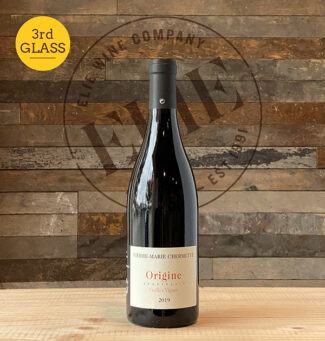 3 – RED
3 – RED
Beaujolais 2019, Pierre-Marie Chermette – Vissoux ‘Origine Vieilles Vignes’ ($19): Traditionally, Beaujolais is Thanksgiving’s most reliable stand-by; it’s fun and versatile and represents some of the best value wines from an underappreciated region of France. The carefree sensations that accompany a draught of Beaujolais underscore the simple joy of wine often overlooked by pedantics. Place two hours in the refrigerator before serving. 12.5% alc.
1 – Manoir du Kinkiz (Brittany, France)
Early in life, Hervé Seznec knew that he wanted to recreate the heralded artisan ciders of his Brittany ancestors, and at the age of 19, he planted 74 acres of orchard with nearly 25 varieties of apples. He uses no pesticides (ladybugs provide insect control) and ages his bitter-sweet product in oak foudres, allowing for natural carbonation to develop with the juice.
2 – Can Sumoi (Catalunya, Spain)
At two thousand feet above sea level (in the Serra de l’Home range) Can Sumoi is the highest estate in the Penedès and represents a collaboration between two childhood pals, Pepe Raventós and Francesc Escala. The 350-year-old farmhouse that is the focal point of the estate sits above 75 acres planted to Montonega, Xarel-lo and Sumoll vines.
3 – Pierre-Marie Chermette Vissoux (Beaujolais)
Pierre-Marie Chermette was raised in a vineyard, and he pursued winemaking as his life’s work, earning National Diploma of Oenologist from Dijon at the age of 20. Two years later, he developed estate-bottled wines, and over the years, he diversified the number of appellations the family worked, and is now responsible for nearly 75 acres.
A TOAST
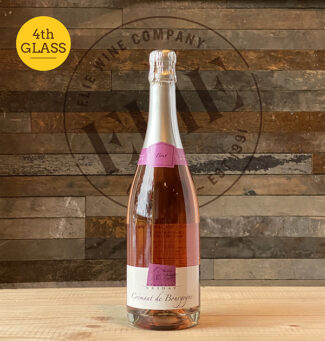 When we raise our glasses at a Thanksgiving gathering, we’re often called upon to toast the earthly things for which we are most appreciative. Sparkling wine must surely wind up on everyone’s list; it has been said, “You can have too much, but you can never have enough.” The only drawback to Champagne has traditionally been price, but a marvelous, affordable alternative is ‘Crémant’—sparkling wine made outside the Champagne region, generally with as much care and often at a similar quality level.
When we raise our glasses at a Thanksgiving gathering, we’re often called upon to toast the earthly things for which we are most appreciative. Sparkling wine must surely wind up on everyone’s list; it has been said, “You can have too much, but you can never have enough.” The only drawback to Champagne has traditionally been price, but a marvelous, affordable alternative is ‘Crémant’—sparkling wine made outside the Champagne region, generally with as much care and often at a similar quality level.
4 – Domaine Michel Briday (Burundy)
Founded in 1976 by Michel and Lucette Briday, the original 15 acres (today managed by Michel’s son and daughter-in-law, Stéphane and Sandrine) has expanded to 38 acres spread across the municipalities of Rully, Bouzeron, and Mercurey. They have forged a reputation for producing Côte Chalonnaise wines that respect the vineyards and showcase their unique terroirs.
SERVE WITH DINNER
Roast turkey is synonymous with Thanksgiving of course, although it is by no means a mandate. Not only that, but the accompaniments—traditional or novel—represent a wide variety of textures, flavors and attitudes, from crunchy to sweet and unctuous to salty. It’s often wise to curate a selection of wines rather than look for a perfect pairing to a single wine, or even a single style. These four selections offer a range of options, a weight for every side course and a flavor for every palate.
 5 – WHITE
5 – WHITE
Alsace Riesling 2019, Domaine Weinbach ($35): Riesling is the darling of Alsace, and it vinifies it dry and razor sharp. Like the Germans, they baby this varietal through cool weather, and like the French, they put full emphasis on the representation of terroir. That makes them nuanced while remaining perfectly food friendly with a cornucopia of trimmings, a pronounced minerality shoring up the wine’s pear, apple, lemon and spice notes.
 6 – ROSÉ
6 – ROSÉ
Gigondas 2020, Château de Montmirail ‘Cuvée du Rossignol’ ($25): Gigondas, where some of Rhône’s most prestigious red wines are produced, is also capable of producing luminous and ultra-refreshing pink wines from the same grapes. If Goldilocks were old enough to drink, she’d call Rhône rosé ‘just right’, neither too big nor too small, with the right amount of sweetness foiled by tart acidity. Serve cold.
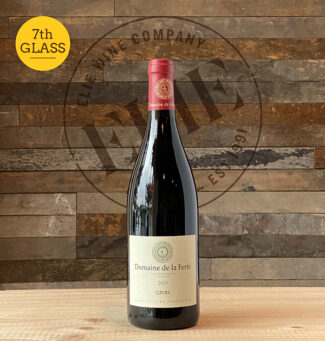 7 – RED
7 – RED
Givry 2019, Domaine de la Ferté ($37): In tackling Thanksgiving wines, food and wine writers alike have long heralded Pinot Noir for its inherent earthiness and notes of vanilla and nutmeg, making it a natural pairing for cranberries, dark meat turkey and root vegetables. Nowhere better to find the ideal Pinot Noir than in the heart of Givry—where the red wines are tannic enough to offset foods higher in fat, but fruity enough to compliment sweeter accompanying dishes. Serve mildly cold. Place 90 minutes in the refrigerator before serving.
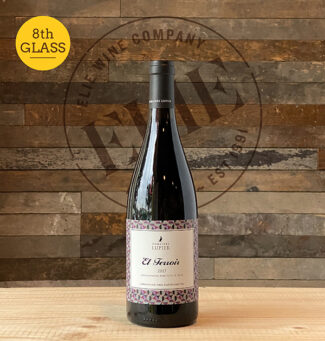 8 – RED
8 – RED
Navarra 2017, Domaines Lupier ‘El Terroir’ ($33): The wild and tasty flavors inherent in Garnacha act as savory validation to common Thanksgiving herbs like sage, rosemary, and thyme, and as a result, it works with the entire meal. Navarra, a region in Northern Spain perhaps better known more for Tempranillo and Cab/Merlot blends, is beginning to develop an international reputation for energetic, charming red Garnachas. Place one hour in the refrigerator before serving.
5 – Domaine Weinbach (Alsace)
What is now Domaine Weinbach was first established as a 12-acre Capuchin monastery in 1612, remaining so until the French Revolution, when it went into state ownership. The current owner is Catherine Faller, whose grandfather and great uncle bought the estate in 1898; her father Théo developed it to its current size of nearly a hundred acres. Situated at the foot of the majestic Schlossberg hill, Weinbach is particularly well-known for its richly concentrated and fragrant Rieslings.
6 – Château de Montmirail (Southern Rhône)
Established in 1960 by Maurice Archimbaud, Château de Montmirail is now managed by his daughter, Monique Archimbaud Bouteiller and her children. The vineyard straddles two communes, Vacqueyras and Gigondas, and is the result of Maurice Archimbaud merging two properties: An inherited family farm in Vacqueyras and a slightly larger one in Gigondas he created by clearing steep slopes on Dentelles de Montmirail. Today, the combined 60 acres sprawl across clay/limestone terrain, ideal for producing wines with structure, savory overtones and deeply intense color.
7 – Domaine de la Ferté (Burgundy)
The abbey of Ferté, the first of its kind to be built in Citeaux, was established in 1113, and the resident monks quickly developed and maintained vineyards in Givry, making it the epicenter of wine production in the Côte Chalonnaise. Givry was the preferred source for King Henri IV’s wines in the 16th Century, and still represents some of best values in the Côte. Today, Domaine de la Ferté is one of five estates owned by the Devillard family; Ferté covers a relatively small area of six acres spread over three plots, two in the village appellation of Clos Mortière and one in Servoisine Premier Cru. It thrives under the direction of enologist and ‘chef de culture’ Enrico Peyron.
8 – Domaines Lupier (Navarra, Spain)
Enrique Basarte and Elisa Ucar may be a force of nature, but they never force nature. The duo’s fascination with old vine Garnacha led them to purchase more than two dozen parcels of vines near the high-altitude village of San Martín de Unx, which they have farmed biodynamically from the outset. Extremely low yields from vines more than a century old are tenderly aged for fourteen months in oak, resulting in sumptuous Garnacha unlike any found elsewhere in the world.


- - -
Posted on 2021.11.19 in Givry, Beaujolais-Villages, Côte Chalonnaise, France, Beaujolais, Spain DO, Penedes, Burgundy, Wine-Aid Packages, Southern Rhone, Navarra, Alsace | Read more...
The Essential Thanksgiving Wine: Burgundy’s Joyful Beaujolais Pairs Well with Feast’s Myriad of Dishes, Five Producers in Ten Appellations & Shades (10-Bottle Pack $335)
G.K. Chesterton considered gratitude to be the highest form of thought; John F. Kennedy once wrote, “As we express our gratitude, we must never forget that the highest appreciation is not to utter words, but to live by them.”
In private or in public, Americans set aside a single day of the year to express such sentiments, highlighted by a meal that may be emblematic of our national diversity with its multitude of textures, flavors and aromas. The quest for perfect wine pairings adds an unnecessary level of stress to a day of giving thanks, so again—as in years past—Beaujolais comes to the rescue. A wine that is both elegant and refreshing, energetic and multifaceted, Beaujolais can flow easily throughout the meal and stand up to the unctuous richness of roast bird and the acidity in Aunt Grace’s salad. And, as always, at a price that belies its quality. Beaujolais remains a wine that is simultaneously uncomplicated and consequential and which echoes G.K Chesterton’s conviction that gratitude is “happiness doubled by wonder.”
Even the word ‘Beaujolais’ sounds lighthearted as it rolls from the tongue. French for ‘beautiful hill’, the Beaujolais AOP drapes across the undulating, vine-covered hillsides south of Burgundy where a plethora of wineries (mostly family-owned) have built a legacy around a single theme: The Gamay grape. In the northern part of the appellation—where the soils are granitic—earthy, terroir-focused wines of great complexity are made, and among the best of these vineyards, ten individual Crus are rated as exceptional. Further south, where the topography is flatter and the soils are heavier with limestone clay, winemakers take a more generic approach to the craft, resulting in softer, fruit-driven and user-friendly red wines that represent excellent values.
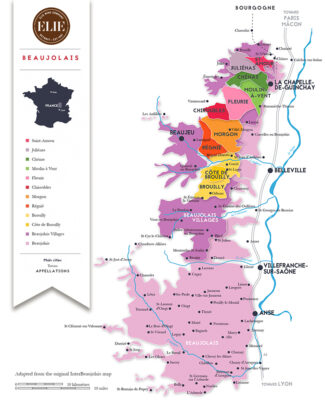
This special package contains one of each of the following 10 wines for $335.
Pierre-Marie Chermette (Vissoux)
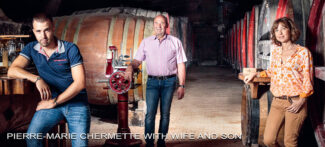
Pierre-Marie Chermette has been at the helm of this family-owned estate since 1982. With his wife Martine and son Jean-Étienne, his Beaujolais wines (with acres in Fleurie, Brouilly & Moulin-a-Vent) are crafted using standard techniques, but without chaptalization, keeping yields low and allowing extended hang times for his grapes. His wines are said to be so natural that they resemble what one have been served in a Lyon café in the 1940’s.
 Beaujolais Rosé 2020, Pierre-Marie Chermette – Vissoux ‘Griottes’ ($18): Les Griottes means ‘small cherries’—a reference to the cherry orchard that lies adjacent to this single-acre parcel; the wine is drawn from 20 to 40-year-old vines grown on dark, granite soils around the Chermette homestead in Saint-Vérand. Pierre-Marie has never made his rosé by the saignée method—bleeding juice from a tank of red Beaujolais to make it more concentrated—but has always vinified rosé as a separate wine. It is light and sappy, dry and energetic, with notes of ripe tangerine and strawberry and hints of candied rose and succulent herbs.
Beaujolais Rosé 2020, Pierre-Marie Chermette – Vissoux ‘Griottes’ ($18): Les Griottes means ‘small cherries’—a reference to the cherry orchard that lies adjacent to this single-acre parcel; the wine is drawn from 20 to 40-year-old vines grown on dark, granite soils around the Chermette homestead in Saint-Vérand. Pierre-Marie has never made his rosé by the saignée method—bleeding juice from a tank of red Beaujolais to make it more concentrated—but has always vinified rosé as a separate wine. It is light and sappy, dry and energetic, with notes of ripe tangerine and strawberry and hints of candied rose and succulent herbs.
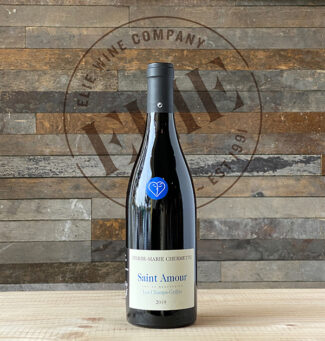 Saint-Amour lieu-dit ‘Les Champs Grillés’ 2019, Pierre-Marie Chermette – Vissoux ($30): First officially recognized in 1964, the seven-acre plot of Les Champs Grillés is renowned for its shale-infused, pink granite soils which can produce wines of incredible finesse; flowery, plush, soft, yet powerful. The southeast-facing vineyard permits long hang-times and extended ripening, and the wine is lovely and lively, displaying strawberries, orange rind and rose petals with a crunchy core of fruit.
Saint-Amour lieu-dit ‘Les Champs Grillés’ 2019, Pierre-Marie Chermette – Vissoux ($30): First officially recognized in 1964, the seven-acre plot of Les Champs Grillés is renowned for its shale-infused, pink granite soils which can produce wines of incredible finesse; flowery, plush, soft, yet powerful. The southeast-facing vineyard permits long hang-times and extended ripening, and the wine is lovely and lively, displaying strawberries, orange rind and rose petals with a crunchy core of fruit.
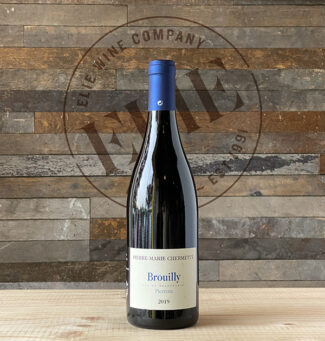 Brouilly lieu-dit ‘Pierreux’2019, Pierre-Marie Chermette – Vissoux ($27): Brouilly is the southernmost of the Beaujolais Crus, and the climat ‘Pierreux’ (from ‘pierres’, or ‘stones’) lives up to its name. Situated at the foot of Mount Brouilly, the soils consist of granite scree eroded from the hillside, creating an environment ideal for long-lived Beaujolais with a pronounced minerality.
Brouilly lieu-dit ‘Pierreux’2019, Pierre-Marie Chermette – Vissoux ($27): Brouilly is the southernmost of the Beaujolais Crus, and the climat ‘Pierreux’ (from ‘pierres’, or ‘stones’) lives up to its name. Situated at the foot of Mount Brouilly, the soils consist of granite scree eroded from the hillside, creating an environment ideal for long-lived Beaujolais with a pronounced minerality.
Justin Dutraive
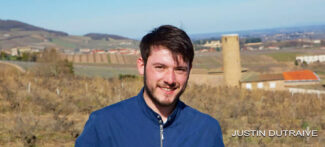
Justin Dutraive established his label in 2015, but—although he is now only 23—he brought to it many years of experience working with his legendary father Jean-Louis Dutraive at Domaine de la Grand’Cour in Fleurie and a solid oenological education. He spent time at Jean Foillard and Julie Blagny in Beaujolais, in Oregon and at Sinapius and Gentle Folk in Australia. He thinks big, but for now, operates small; his entire domain is under five acres—one within the Beaujolais Villages appellation below the town of Fleurie, and another parcel within La Chapelle des Bois. He produces no more than a few thousand bottles of each cuvée, allowing him total control over the farming and vinification, or as much control as he chooses when winemaking is done naturally, using the lightest touch possible. “While the foundation of Beaujolais is set,” Justin maintains, “the future is paved by the principles of organic and biodynamic viticulture along with the most natural approach possible in the cellar.”
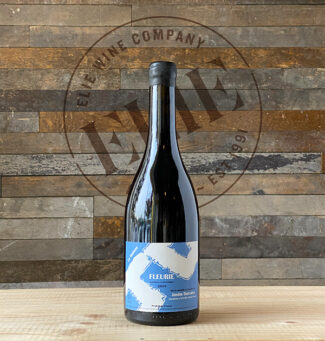 Fleurie lieu-dit ‘La Madone’ 2018, Justin Dutraive ‘raw’ ($52): La Madone is one of the emblematic terroirs of Fleurie, and fittingly, Dutraive’s tiny, quarter-acre parcel is owned by his mother, who lives near the top of the famous hillside. Soils are rich in granite and vines were planted in 1951; after a cold maceration and fermentation without pump-overs, the wine spends six months in stainless steel and is bottled without filtering. The wine displays expansive, mineral-accented blue fruit along with hints of white pepper and candied licorice.
Fleurie lieu-dit ‘La Madone’ 2018, Justin Dutraive ‘raw’ ($52): La Madone is one of the emblematic terroirs of Fleurie, and fittingly, Dutraive’s tiny, quarter-acre parcel is owned by his mother, who lives near the top of the famous hillside. Soils are rich in granite and vines were planted in 1951; after a cold maceration and fermentation without pump-overs, the wine spends six months in stainless steel and is bottled without filtering. The wine displays expansive, mineral-accented blue fruit along with hints of white pepper and candied licorice.
Thibault Liger-Belair

The estate (originally called Comte Liger-Belair) was created in 1720 in Nuits-Saint-Georges, and soon became one of the most important wine growing and trading houses in Burgundy. After many years and successive generations had met with varying degrees of success, Thibault Liger-Belair took over in 2001, and found the 20-acre estate in need of some attention. His immediate switch to organic farming was a matter of necessity as much as responsible stewardship: “The vineyards were in a bad condition, with compacted soils. I couldn’t do anything else other than organics,” he says, and in 2004, discovered biodynamics. “I saw a change in my vineyard, which went from grey soils to brown/red and then sometimes to black.” Still, his overarching philosophy is that each vineyard needs something different: “I don’t like 100% of anything: new barrels, whole clusters. My job is to decide which grapes we have and then decide a viticulture and winemaking approach.” In 2018, he made wine from 23 different appellations and purchased grapes from a ten more, but did the work there. “We don’t purchase grapes where we don’t do the work,” he says.
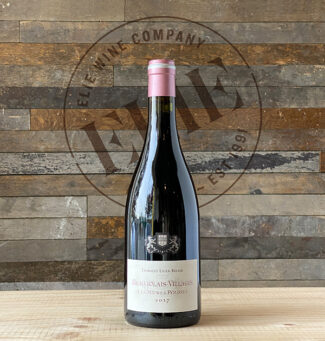 Beaujolais-Villages 2017, Thibault Liger-Belair ‘Les Jeunes Pousses’ ($28): ‘Jeunes Pousses’ means ‘young plants’, and although the ten-acre vineyard contains vines planted between 1920 and 1982, the Villages bottling focuses on fruit from the younger vines. Soils are granitic and sandy and produce wines with grip and length; this one shows blackberry and blueberry scents over a rich palate with spice and vanilla.
Beaujolais-Villages 2017, Thibault Liger-Belair ‘Les Jeunes Pousses’ ($28): ‘Jeunes Pousses’ means ‘young plants’, and although the ten-acre vineyard contains vines planted between 1920 and 1982, the Villages bottling focuses on fruit from the younger vines. Soils are granitic and sandy and produce wines with grip and length; this one shows blackberry and blueberry scents over a rich palate with spice and vanilla.
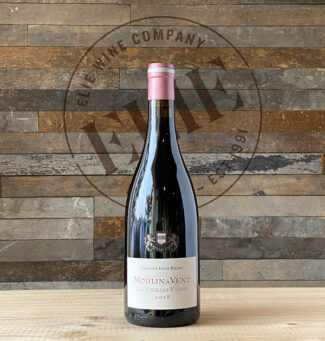 Moulin-à-Vent 2018, Domaine Thibault Liger-Belair ‘Les Vieilles Vignes’ ($45): A cuvée blending 9 parcels of old vines between 65 and 105 years old; Liger-Belair himself considers this the representative wine of the estate, since the vineyards contained within come from 15 acres representing half of the total estate. The parcels are located in a belt around the Moulin à Vent hill, and the wine displays kirsch and orange blossom over a structured backbone of fruit and tannin.
Moulin-à-Vent 2018, Domaine Thibault Liger-Belair ‘Les Vieilles Vignes’ ($45): A cuvée blending 9 parcels of old vines between 65 and 105 years old; Liger-Belair himself considers this the representative wine of the estate, since the vineyards contained within come from 15 acres representing half of the total estate. The parcels are located in a belt around the Moulin à Vent hill, and the wine displays kirsch and orange blossom over a structured backbone of fruit and tannin.
Domaine de Rochegrès

In 2014, the Rochegrès vineyard in Moulin-à-Vent was purchased by Maison Albert Bichot. At around twelve acres, the majority of the vines are 80 to 100 years old, and like the other estates owned by this historic Maison, Rochegrès has been allowed to keep its independence. Alain Margerand, Rochegrès head winemaker since 1987, continues to create the domain’s unique wines, which are beginning to be seen as a benchmark in the Moulin-à-Vent appellation.
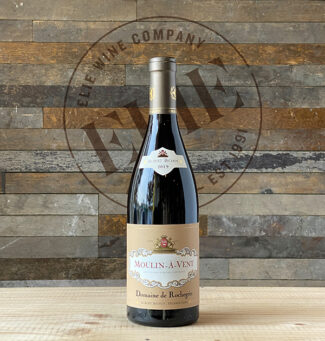 Moulin-à-Vent 2019, Domaine de Rochegrès ($26): From five acres of very old (80 – 100 years) vines at the core of Rochegrès’ single vineyard. ‘Roche’ suggests rock, and indeed, the granite that forms the base of the terroir is visible at the surface. Such soils force roots to dig deeply to find nutrients, and add an undeniable complexity that vines grown in shallow fertile soils cannot approach. The wine is a blend of several lieux-dits, including La Rochelle and au Mont, and displays opulent notes of rose, peony and violet on the nose, with dark cherry and strawberry leading to an extended finish.
Moulin-à-Vent 2019, Domaine de Rochegrès ($26): From five acres of very old (80 – 100 years) vines at the core of Rochegrès’ single vineyard. ‘Roche’ suggests rock, and indeed, the granite that forms the base of the terroir is visible at the surface. Such soils force roots to dig deeply to find nutrients, and add an undeniable complexity that vines grown in shallow fertile soils cannot approach. The wine is a blend of several lieux-dits, including La Rochelle and au Mont, and displays opulent notes of rose, peony and violet on the nose, with dark cherry and strawberry leading to an extended finish.
Daniel Bouland

In Beaujolais, Daniel Bouland is known as a bit of a recluse who produces some of the most remarkable old-school Morgons that the AOP can offer. Drawn from around twenty acres of old vines in the lieux-dits of Douby, Côte de Py, and Delys plus small parcels in Chiroubles and Côte de Brouilly, his wines are drinkable upon release (although Daniel himself recommends five years in bottle for the terroir to show the wine’s true sense of clarity and mineral nuance) but are fleshy enough to age for a decade beyond that. All his grapes are hand-harvested and vinified with full clusters in order to extract the full gamut of organoleptic qualities, and bottled unfiltered.
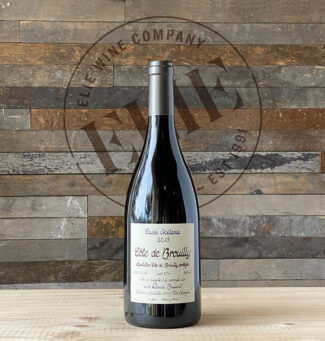 Côte de Brouilly 2019, Daniel Bouland ‘Cuvée Mélanie Cuve No 1’ ($36): Named for his daughter, Daniel’s parcel of old vine Gamay lies within the lieu dit Tête Noire, high on the southern slope of Brouilly, which—like Côte de Py in Morgon—is composed of volcanic blue schist. This terroir gives the wine a distinctive minerality that matches its smoky elegance and richly spiced blackberry, plum and cassis flavors.
Côte de Brouilly 2019, Daniel Bouland ‘Cuvée Mélanie Cuve No 1’ ($36): Named for his daughter, Daniel’s parcel of old vine Gamay lies within the lieu dit Tête Noire, high on the southern slope of Brouilly, which—like Côte de Py in Morgon—is composed of volcanic blue schist. This terroir gives the wine a distinctive minerality that matches its smoky elegance and richly spiced blackberry, plum and cassis flavors.
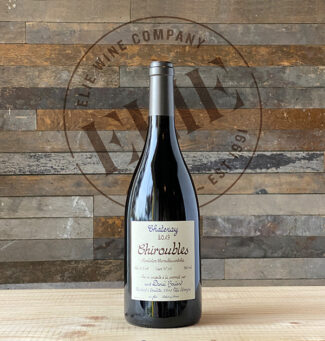 Chiroubles lieu-dit ‘Chatenay’ 2019, Daniel Bouland ‘Cuve No 11’ ($36):Of the ten Crus in Beaujolais, Chiroubles contains vineyards at the highest overall altitudes; as a result, the wines are intensely perfumed and delicate. Bouland’s acre-and-a-half plot of Chatenayconsists of 30-year-old vines grown in friable yellow sandstone and offers bright red fruit and wildflower on the nose, a fleshy mid-palate and mature, powdery tannins.
Chiroubles lieu-dit ‘Chatenay’ 2019, Daniel Bouland ‘Cuve No 11’ ($36):Of the ten Crus in Beaujolais, Chiroubles contains vineyards at the highest overall altitudes; as a result, the wines are intensely perfumed and delicate. Bouland’s acre-and-a-half plot of Chatenayconsists of 30-year-old vines grown in friable yellow sandstone and offers bright red fruit and wildflower on the nose, a fleshy mid-palate and mature, powdery tannins.
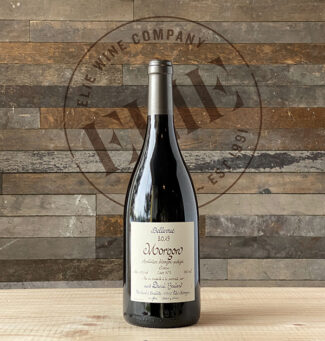 Morgon lieu-dit ‘Bellevue’ 2019, Daniel Bouland ‘Cailloux Cuve No 3’ ($37):Bellevue is a lieu-dit located above the heralded Corcelette, and the ‘Cailloux’ bottling comes from 80-year-old vines planted on a specific rootstock (420A) designed for stony terroirs with very little topsoil. The ‘cuve’ in Bouland’s labels indicate an individual ‘cuve’ (not to be confused with cuvée), a concrete aging tank. The wine is supple and velvety, showing beautiful structure and aromas of ripe plums, cocoa, wild berries and spice.
Morgon lieu-dit ‘Bellevue’ 2019, Daniel Bouland ‘Cailloux Cuve No 3’ ($37):Bellevue is a lieu-dit located above the heralded Corcelette, and the ‘Cailloux’ bottling comes from 80-year-old vines planted on a specific rootstock (420A) designed for stony terroirs with very little topsoil. The ‘cuve’ in Bouland’s labels indicate an individual ‘cuve’ (not to be confused with cuvée), a concrete aging tank. The wine is supple and velvety, showing beautiful structure and aromas of ripe plums, cocoa, wild berries and spice.
Notes on Vintages in Beaujolais
Vintage 2017: Unnerving But Successful
Justin Dutraive summarizes the 2017 vintage in Beaujolais as ‘hot, dry, and ripe’: “Fruit was juicy, which led to very fresh, very clean juice.” Late April frosts which ran havoc through other French vineyards largely spared Beaujolais, but the appellation was not as fortunate in July, when catastrophic hail storms slashed many growers’ production volumes for the second year in a row, both in the Beaujolais Villages zone and those of the Crus. Some growers in both Morgon and Moulin-à-Vent lost 80% of their crop, but the fruit that remained was concentrated and cellar-worthy.
Vintage 2018: Rich With Breath of Freshness
A wet and mild winter gave way to a heat wave in early spring, although a cold spell followed, slowing down flowering until late May. The summer was in hot, dry and sunny (August 2018 was the hottest in Beaujolais since 1959), and harvest began in late August, though in many of the best cru sites growers had to wait until full phenolic ripeness came in September. The harvest was, even by Beaujolais standards, abundant.
Vintage 2019: ‘Solar’ Vintages Continue
Budburst came early, and frosts in early April decimated potential yields, further exasperated by August hail, with the southern half of the appellation being the most affected. The crus were largely spared, but saw rain instead which helped the crop mature after a fiercely hot summer. At the final tally, the harvest was half the size of the generous 2018 crop, and a quarter down from a five-year average.
Vintage 2020: A Vintage With Great Drinkability
Although some of the fanfare associated with the early release of Beaujolais Nouveau was compromised by Covid, the harvest was not. Overall, the season was ideal, with a mild spring and a hot summer without major storms or hail. The vintage shows rich, ripe flavors, although the excessive heat caused sugar spikes in the fruit that led to higher alcohol than usual.
- - -
Posted on 2021.11.14 in Chirouble, Morgon, Cote de Brouilly, Saint-Amour, Moulin-à-Vent, Fleurie, Beaujolais-Villages, France, Beaujolais, Wine-Aid Packages | Read more...
The Champagne Society October 2021 Selection: Champagne Laherte Frères
Champagne Laherte Frères
‘Cuvées Terroir Fundamentals’

Special price for members of the Champagne Society is $79. (SOLD-OUT)
‘Progressive’ is not a word one traditionally sees affixed to Champagne producers, because, well… tradition. But shifting dynamics in consumer tastes and perhaps more significantly, changes in global climate patterns, have invigorated a new generation of vignerons to rethink some Champagne parameters. Aurélien Laherte is among them.
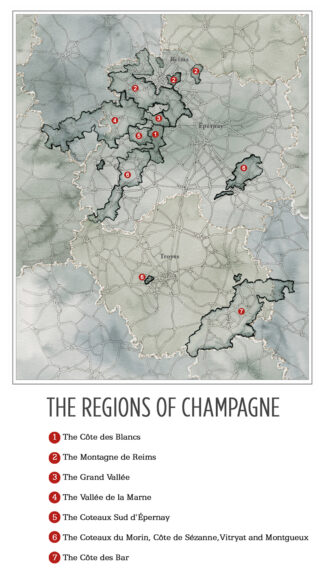
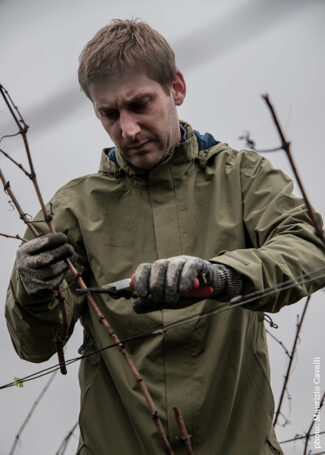 The Laherte family is by no means a regional upstart; Champagne Laherte Frères was founded in 1889, made up primarily of vines in the village of Chavot-Courcourt. The 25 acres estate from which the estate sources across 75 parcels in 10 nearby villages have been passed down through the generations, and all are still owned and tended by members of the immediate family. Fourth generation vigneron Michel Laherte expanded the holding and began working the soil organically and patiently, extracting the full terroir expression in the wines—a philosophy which endures today.
The Laherte family is by no means a regional upstart; Champagne Laherte Frères was founded in 1889, made up primarily of vines in the village of Chavot-Courcourt. The 25 acres estate from which the estate sources across 75 parcels in 10 nearby villages have been passed down through the generations, and all are still owned and tended by members of the immediate family. Fourth generation vigneron Michel Laherte expanded the holding and began working the soil organically and patiently, extracting the full terroir expression in the wines—a philosophy which endures today.
Aurélien took the reins in 2005, and has embraced the idea of producing a series of tiny production, single-vineyard, single vintage cuvées (around 3,000 bottles each) from some of the estates most unique and expressive parcels.
An ecological approach is taken, with half the vineyard holdings managed biodynamically, and the rest essentially organically, ‘to facilitate the natural expression of the vine and increase its aromatic potential,’ Aurélien explains.
’More than anything, my father and I are trying to respect the soil, expressing the style of the clay and limestone,’ says the young Laherte. This is the soil of the historic little village of Chavot-Courcourt, on the border of the Côte de Blancs, and the Vallée de la Marne. ‘The clay gives us Chardonnay that is fruitier than the Côte des Blancs, and the limestone Meunier that is finer than the Vallée de la Marne,’ he says.
Villages, crus and varieties are separated. The majority of the parcels are fermented and aged in oak, as has been the tradition for more than 25 years. Barrels vary from four to 40 years of age, and include several large 100-year-old foudres from Alsace. Five small barrels are purchase each year from Domaine de la Romanée-Conti where they have aged Le Montrachet, no less. Some lees stirring is performed to build richness. Malolactic fermentation is blocked in most cuvées, but may proceed spontaneously or by design for particular years and varieties. For a total production of 120,000 bottles, Laherte Frères boasts of 11 cuvées that preserve the detail of its terroirs in wines of taut, linear persistence, and at times assertive structure.
Due to the small quantities of each of the several cuvées Aurélien is allocating to us, I have selected three equally priced cuvées to assign to the members at random.
Winemaker Notes …
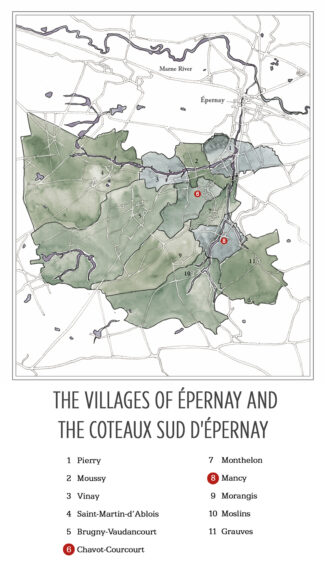
Surprising & Delicate: A Tribute to Our Ancestors
Les Vignes d’Autrefois 2016
Vieilles Vignes de Pinot Meunier (Côteaux Sud d’Épernay – Villages Chavot & Mancy) Extra-Brut
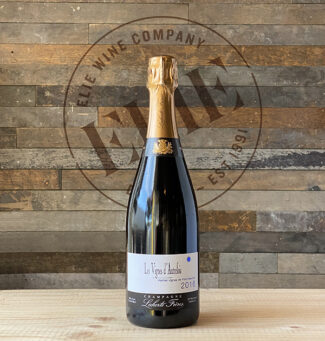
“100% Pinot Meunier. The selected plots have been planted by our forefathers between 1947 and 1953. (Terroir of Village Chavot – ‘Les Rouges Maisons’, ‘Les Monts Bougies’: Clay and silty soil with a presence of flint and little stones, chalky subsoils. Terroir of Village Mancy – ‘Les Hautes Norgeailles’: Clay soils with a little silt, stratum in surface, halky subsoil.) Many generations followed one another in order to preserve this patrimony and keep all the qualities of these old vine stocks, some have been planted on franc de Pied). Grapes harvested by hand. Traditional press. Alcoholic fermentation in barrels. Aging in barrels on lees with no malolactic fermentation. 3277 bottles produced.”
Dosage: 2 to 4 grams per liter
Disgorgement: January 2020 by hand
Tasting Notes
“Bright and vibrant in the glass, the 2016 offers a compelling interplay of Meunier richness with striking layers of intense minerality that open over time. Sweet floral notes add inner perfume and the closing flourishes of finesse.” Vinous
or
Delicate & Structured: Terroir and Variety Interplay
Les Grandes Crayères 2016
Blanc de Blancs Millésime (Côteaux Sud d’Épernay – Village Chavot) Extra-Brut

“100% Chardonnay. Selection Massale and blend of new and old rootstocks. Born of the particular and complex Terroir of Les Coteaux Sud d’Épernay, a few plots have soft soils and the campanian chalk is present at 20 cm. In 2014, we decided to vinify separately and create a new single vineyard cuvée to present Chardonnay with finesse and relief. Grapes harvested by hand. Traditional press. Alcoholic fermentation in barrels. Aging in barrels on lees with no malolactic fermentation. 3893 bottles produced.”
Dosage: 3 to 4 grams per liter
Disgorgement: January 2020 by hand
Tasting Notes
“Bright and finely sculpted, the 2016 possess dazzling energy to match its mid-weight personality. I very much admire the wine’s drive and precision.” Vinous
or
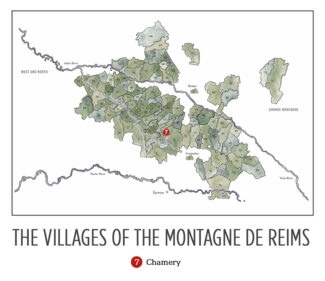
Intense & Straight: Pure Pinot Noir, Perfect Finesse
Les Longues Voyes 2016
Blanc de Noirs Premier Cru (Montagne de Reims – Village Chamery) Extra-Brut
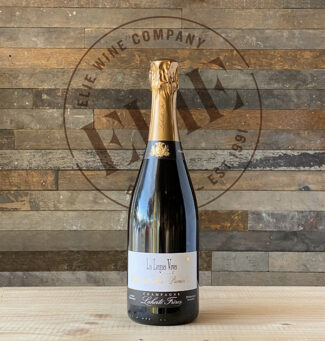
“‘Les Longues Voyes’ (‘The long way’) is 100% Pinot Noir from Village Chamery, situated 30 km from our estate, with clay and silts soil and limestone subsoil. These fine Pinot Noir always take time to achieve optimal maturity. Grapes harvested by hand. Traditional press. Alcoholic and malolactic fermentation in barrels. Extended ageing in barrels on lees for 18 months brings richness and complexity. 2991 bottles produced.”
Dosage: 4 grams per liter
Disgorgement: January 2020 by hand
Tasting Notes
“The dark, brooding side of Pinot emerges as the Longues Voyes starts to open in the glass. There is a real sense of gravitas here. Pear, white flowers, spice and almond are all nicely woven together. Even with all of that intensity, the 2016 retains gorgeous aromatic lift and freshness.” Vinous
- - -
Posted on in France, The Champagne Society, Champagne | Read more...
Featured Wines
- Notebook: A’Boudt Town
- Saturday Sips Wines
- Saturday Sips Review Club
- The Champagne Society
- Wine-Aid Packages
Wine Regions
Grape Varieties
Aglianico, Albarino, Albarín Tinto, Alicante Bouschet, Aligote, Altesse, Arbanne, Arcos, Auxerrois, Barbarossa, Beaune, Biancu Gentile, Bonarda, bourboulenc, Cabernet Sauvignon, Calvi, Carcajolu-Neru, Chenin Blanc, Cinsault, Clairette, Cortese, Corvinone, Cot, Counoise, Dolcetto, Erbamat, Fiano, folle Blanche, Fumin, Gamay, Garganega, Garnacha Tintorera, Godello, Graciano, Grenache, Grenache Blanc, Grolleau, Groppello, Jacquère, Juan Garcia, Lladoner Pelut, Macabeo, Maconnais, Malbec, Malvasia, manseng, Marcelan, Marsanne, Marselan, Marzemino, Melon de Bourgogne, Mencía, Merlot, Montepulciano, Montònega, Moscatell, Mourv, Mourvèdre, Muscadelle, Muscat, Natural, Nebbiolo, Nero d'Avola, Niellucciu, Palomino, Parellada, Patrimonio, Pecorino, Pedro Ximénez, Persan, Petit Meslier, Pineau d'Aunis, Pinot Auxerrois, Pinot Blanc, Pinot Gris, Pinot Meunier, Pinot Noir, Pouilly Fuisse, Pouilly Loche, Riesling, Rousanne, Sagrantino, Sangiovese, Sauvignon, Sciacarellu, Semillon, Serine, Sumoll, Tempranillo, Teroldego, Timorasso, Trebbiano Valtenesi, Treixadura, trepat, Trousseau, Ugni Blanc, Vermentino, Viognier, Viura, Xarel-loWines & Events by Date
- September 2025
- August 2025
- July 2025
- June 2025
- May 2025
- April 2025
- March 2025
- February 2025
- January 2025
- December 2024
- November 2024
- October 2024
- September 2024
- August 2024
- July 2024
- June 2024
- May 2024
- April 2024
- March 2024
- February 2024
- January 2024
- December 2023
- November 2023
- October 2023
- September 2023
- August 2023
- July 2023
- June 2023
- May 2023
- April 2023
- March 2023
- February 2023
- January 2023
- December 2022
- November 2022
- October 2022
- September 2022
- August 2022
- July 2022
- June 2022
- May 2022
- April 2022
- March 2022
- February 2022
- January 2022
- December 2021
- November 2021
- October 2021
- September 2021
- August 2021
- July 2021
- June 2021
- May 2021
- April 2021
- March 2021
- February 2021
- January 2021
- December 2020
- November 2020
- October 2020
- September 2020
- August 2020
- July 2020
- June 2020
- May 2020
- April 2020
- March 2020
- February 2020
- January 2020
- December 2019
- November 2019
- October 2019
- September 2019
- August 2019
- July 2019
- June 2019
- May 2019
- April 2019
- March 2019
- February 2019
- January 2019
- December 2018
- November 2018
- October 2018
- September 2018
- August 2018
- July 2018
- June 2018
- May 2018
- April 2018
- March 2018
- February 2018
- January 2018
- December 2017
- November 2017
- October 2017
- September 2017
- August 2017
- July 2017
- June 2017
- May 2017
- April 2017
- March 2017
- February 2017
- January 2017
- December 2016
- November 2016
- October 2016
- September 2016
- August 2016
- July 2016
- June 2016
- May 2016
- April 2016
- March 2016
- February 2016
- January 2016
- December 2015
- November 2015
- October 2015
- September 2015
- August 2015
- July 2015
- June 2015
- May 2015
- April 2015
- March 2015
- February 2015
- January 2015
- December 2014
- November 2014
- October 2014
- September 2014
- August 2014
- July 2014
- June 2014
- April 2014
- March 2014
- February 2014
- January 2014
- December 2013
- November 2013
- October 2013
- September 2013
- August 2013
- July 2013
- June 2013
- May 2013
- April 2013
- March 2013
- February 2013
- January 2013
- December 2012
- November 2012
- October 2012

